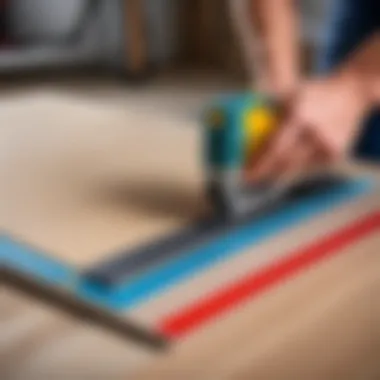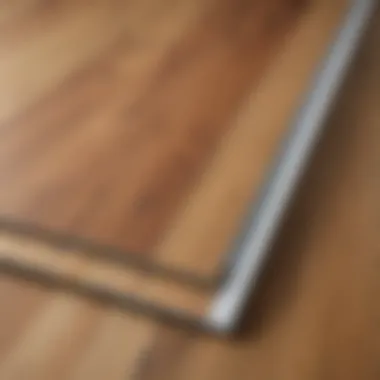Starting Laminate Installation: A Comprehensive Guide


Intro
Installing laminate flooring can transform a space, enhancing its aesthetic appeal while being practical. This process, however, requires careful planning and execution to ensure the best results. For DIY enthusiasts and homeowners, grasping the essential steps can lead to a successful installation that not only looks great but also lasts for years. Understanding how to begin effectively is crucial, so this guide will address the planning and material selection necessary for starting your laminate flooring project.
Проектирование и планирование
Before diving into installation, it is important to plan the project meticulously.
Как выбрать проект для DIY
When selecting a project for DIY, consider factors such as your skill level, available time, and the specific type and style of laminate you wish to install. Assess the area where the laminate will be laid; measure dimensions accurately and think about transitions to other flooring types. This ensures a cohesive look throughout your space.
Additionally, consider the room's purpose. For example, laminate in a high-traffic area will require more durable options. Therefore, you might want to examine the various laminate thicknesses and wear layers available in the market to find a suitable match for your home.
Оценка времени и ресурсов
Allocating time and resources adequately will impact the efficiency of your project. Measure how long you expect the project to take and gather all necessary tools before you start.
- Basic tools needed:
- Materials to consider:
- Tape measure
- Precision saw
- Spacers
- Mallett
- Level
- Safety goggles
- Underlayment
- Laminate planks
- Transition strips
It's also essential to budget for potential unexpected needs and wastage; this can save time and reduce stress throughout the process.
Выбор материалов
The choice of materials can make or break your installation.
Типы материалов для различных проектов
When exploring laminate options, there are various types and styles available, including traditional wood looks and modern designs. Making the right choice depends on your personal taste and the decor of the rest of your home. For example, luxury vinyl laminate provides waterproof features, ideal for kitchens and bathrooms.
It's advisable to check the quality and warranty of the products prior to purchase. Pay attention to the AC rating, which indicates the laminate's durability and suitability for different environments.
Советы по покупке и экономии
To get the best value, shop around. Compare prices both online and in local stores. Keep an eye out for sales and discounts on laminate flooring materials. Additionally, buying in bulk from a reputable retailer can help lower costs.
This preparation phase sets a strong foundation for your installation, ensuring you approach it not only with excitement but also with the right information and resources.
Prologue to Laminate Flooring
The journey into laminate flooring begins with a fundamental understanding of what this material is and the advantages it offers. For many, choosing flooring can be overwhelming due to the vast range of available options. Laminate flooring stands out for its adaptability, cost-effectiveness, and aesthetic appeal. Recognizing these elements is vital for anyone considering this flooring method.
What is Laminate Flooring?
Laminate flooring is a synthetic product that mimics the appearance of natural wood, stone, or tile. It consists of several layers: a core layer made from high-density fiberboard, a design layer, and a protective wear layer on top. This construction gives the laminate both durability and style, allowing it to visually integrate into various home decors. Unlike traditional hardwood or stone, laminate is easier to maintain and is often more affordable.
Advantages of Laminate Flooring


There are many key benefits to laminate flooring, making it a top choice for DIY enthusiasts and homeowners:
- Cost-effective: Laminate is far more affordable than authentic hardwood or stone options. This allows for budget-friendly renovations.
- Easy to install: Many types of laminate flooring come with a click-lock design, making installation straightforward even for beginners.
- Low maintenance: Regular sweeping and occasional mopping are usually enough to keep laminate looking new.
- Versatile designs: Laminate flooring is available in a wide variety of colors and patterns, making it easy to find a style that matches the home’s decor.
- Durability: The wear layer provides resistance against scratches and stains, making it suitable for high foot traffic areas.
Understanding the Different Types of Laminate
In the realm of laminate flooring, there are generally three types:
- Direct Pressure Laminate: This is the most common type. Its layers are fused together with high pressure, resulting in a durable finish.
- High Pressure Laminate: This variety undergoes an even greater amount of pressure during production, resulting in a denser and tougher product. It is often used in commercial applications because of its durability.
- Water Resistant Laminate: An innovative option that improves on traditional laminate by adding waterproof features, relevant in moisture-prone areas like kitchens and bathrooms.
Each type of laminate flooring has its unique characteristics, catering to different needs and preferences. Understanding these types will guide readers in selecting the best fit for their installation project.
Preparation for Installation
Preparation for installation is a crucial stage in any flooring project. It sets the foundation for quality work, ensuring that the laminate flooring will perform and look its best. Neglecting this phase can lead to future complications, including uneven surfaces and premature wear of the flooring materials. Therefore, understanding how to prepare the installation area properly is essential.
Assessing the Installation Area
Before starting the installation, it is vital to assess the area where the laminate will be laid. Check the subfloor for any damage, like cracks or moisture. Unevenness should be leveled out to avoid any complications during installation.
Consider the following factors when assessing the area:
- Cleanliness: Remove any debris, dust, or residues that can interfere with the laminate's adhesion.
- Level Surface: Ensure that the surface is flat, as bumps can create gaps in the laminate flooring.
- Moisture Testing: Use a moisture meter to test the subfloor. High moisture levels can affect laminate performance over time.
- Room Temperature: Ensure that the installation area is within a suitable temperature range, generally between 60°F to 80°F. Immediately repairing any issues found will facilitate a smoother installation process.
Choosing the Right Tools and Materials
The tools and materials selected for laminate installation play a significant role in the quality and ease of the process. Choosing the right tools can improve installation efficiency and reduce mistakes.
Essential Tools Include:
- Laminate Cutter: For precise cuts and clean edges.
- Measuring Tape: Accuracy is paramount. Measure twice, cut once.
- Tapping Block: This helps to connect planks without damaging edges.
- Spacers: Used to maintain an expansion gap around the perimeter of the installation area.
- Rubber Mallet: Useful for tapping planks into place without damaging them.
Make sure to choose high-quality materials too. High-density fiberboards are a good choice for laminate flooring, as they provide durability.
Acclimation of Laminate Planks
Acclimation refers to the process of allowing laminate planks to adjust to the room's temperature and humidity before installation. This step is often overlooked, yet it is fundamental for long-lasting results.
Laminate can expand or contract due to temperature variations. For this reason, store the unopened laminate planks in the installation area for 48 to 72 hours. This will help minimize the risk of buckling or gapping once the planks are laid.
"Proper acclimation is not just a suggestion; it is necessary for achieving a seamless installation and optimal performance of laminate flooring."
By following these preparation steps, you set yourself up for a successful laminate flooring project. This careful preparation ensures that your installation will have a solid foundation, leading to not only aesthetic appeal but also durability in the long term.
Optimal Direction for Laying Laminate
The direction in which laminate flooring is laid significantly affects both the aesthetics and functionality of the space. It influences the visual perception of the room's size and shape. Additionally, it could impact the durability of the flooring. Therefore, understanding the optimal direction for laying laminate is crucial for every DIY enthusiast and professional installer.
Factors Influencing the Direction
Various factors influence the ideal direction for laminate installation. One key consideration is the natural light sources in the room. When laminate boards are installed parallel to the main light source, it can enhance the overall appearance of the flooring. This alignment helps to reduce glare and shadows, making the space feel brighter.


Another important aspect to consider is the layout of the room. For example, in long, narrow rooms, laying the laminate planks lengthwise can create an illusion of space, making the area seem larger. Conversely, in square rooms, a diagonal installation may add visual interest, breaking the monotony of straight lines.
Furthermore, the installation direction should also factor in the adjacent rooms. Consistency across different areas creates visual harmony and enhances overall flow in a home. If connecting with carpet or tile in adjoining rooms, it can be beneficial to match the direction of the laminate with the adjoining flooring to ensure a seamless transition.
Standard Practices in Laminate Installation
There are established practices that many installers follow to ensure optimal laminate direction. First, it is generally recommended to lay laminate from left to right, starting at the longest wall or the primary entrance of the room. This method allows the finished edges to be directed toward the entrance, giving a more aesthetically pleasing look.
A common practice also includes checking the manufacturer's guidelines. Different laminate products may have specific recommendations based upon their design and construction. Importantly, always carry out a dry run before final installation to identify any potential issues with the layout or cuts.
Comparative Analysis of Different Directions
When comparing different installation directions, it is crucial to weigh the pros and cons of each option. For instance, when laying flooring parallel to a wall, the result can often be perceived as more traditional. This alignment could be preferable in settings aiming for a classic or formal aesthetic.
On the other hand, diagonal installations can create a dynamic look, offering a contemporary feel. However, it often requires more cuts, leading to increased waste and longer installation time. In contrast, a straight installation can be quicker and results in less waste.
"Choosing the right direction for laying laminate can transform the very essence of your interior design."
As a result, careful planning and consideration are essential to achieving a desirable outcome.
Step-by-Step Installation Guide
The Step-by-Step Installation Guide is crucial for achieving a successful laminate flooring project. This segment lays out a clear pathway from the initial preparation to the final adjustments, ensuring that the installation is executed with precision. Each step is designed to address specific elements of the process, catering to both novice DIY enthusiasts and seasoned professionals. By breaking down the installation into manageable tasks, this guide encourages confidence and efficiency while minimizing the potential for errors.
Preparing the Subfloor
Before laying laminate, the subfloor requires careful preparation. An uneven or dirty subfloor can lead to complications during installation and might jeopardize the integrity of the laminate. Start by cleaning the area to remove any dust, debris, or old flooring materials. Ensure the subfloor is level; any high spots should be sanded down while low spots might need a leveling compound. This practice helps in ensuring that the laminate lies flat, preventing future buckling or shifting.
Additionally, check for moisture. Excessive moisture can be detrimental, leading to warping or mold growth. Use a moisture barrier if needed, especially in high humidity areas. Following these steps meticulously guarantees a stable foundation for your laminate flooring.
Laying the First Row of Laminate
The first row of laminate is pivotal in determining the entire installation’s alignment. Begin by placing the planks along the longest wall in the room, ensuring they are straight. Utilize spacers to maintain an expansion gap between the panels and the wall, which allows for necessary movement due to humidity changes.
When connecting the planks, follow the manufacturer’s instructions closely. It is often essential to angle the plank into place before pressing down to secure it. Properly laying the first row sets the tone for the remainder of the installation, ensuring a clean and linear look throughout the space.
Continuing the Installation Process
Once the first row is complete, the installation process continues with the next rows. It is crucial to stagger the seams of the planks. This means that the ends of the planks in adjacent rows should not align. Staggering helps to enhance the visual appeal and structural strength of the flooring. As you progress, keep an eye on the overall layout, adjusting as necessary to maintain a balanced and flowing look.
During installation, always check for any gaps or misalignments. Use a tapping block and a pull bar to ensure a tight fit between planks. This aspect affects both the aesthetics and the durability of the floor.
Trimming and Fitting Around Obstacles
Often, installations involve various obstacles such as door frames, vents, or columns. Trimming and fitting around these features requires careful measurement and cutting. Use a jigsaw or a laminate cutter for precise cuts, ensuring that all edges are smooth to prevent any visible gaps.
Measure twice before cutting to avoid mistakes. It is beneficial to dry fit the cut pieces before final placement. Gaps can disrupt the visual continuity and make the floor appear unfinished. Follow up with a caulking or molding to conceal any small spaces left behind, ensuring a polished look.
Final Steps and Refinements
Completing the installation of laminate flooring involves final adjustments that contribute to the overall outcome. Remove all spacers and check if all planks are securely joined. If any creaking or movement is noticed, address those areas immediately—this is crucial for long-term performance.


Next, install transition strips in doorways to create a seamless transition between different floor types. Regular cleaning and maintenance routines should be established to preserve the quality and shine of the laminate. Following these finishing steps will leave you with a professional-looking floor that adds beauty to your space.
"Proper installation is key for laminate flooring longevity, affecting both its aesthetics and durability."
By following this detailed guide, any installation task can be approached with clarity and confidence, ensuring a successful outcome.
Post-Installation Care
Proper post-installation care is essential to maintain the integrity and appearance of laminate flooring. While the initial installation focuses on the meticulous placement of planks, it is the ongoing care that sustains their longevity and beauty. Homeowners must recognize that laminate flooring, though durable, requires specific maintenance routines to prevent damage and prolonged wear.
One of the primary considerations in post-installation care is understanding how to maintain laminate flooring. Regular cleaning is critical. Dusting or sweeping helps prevent the accumulation of dirt and debris that can scratch the surface. For deeper cleaning, using a damp mop with a mild cleaner specifically designed for laminate surfaces is advisable. Excessive moisture can lead to warping, so it is best to avoid soaking the floors.
Moreover, placing area rugs in high-traffic zones can further protect the flooring from scratches. This focus on cleanliness ensures the floor retains its aesthetic appeal over time.
Key takeaway: Consistent maintenance contributes significantly to the lifespan and visual integrity of laminate flooring.
Understanding Basic Maintenance
Basic maintenance includes simple yet effective practices. Starting, always remove shoes at the entrance to minimize dirt transfer. This simple action can greatly reduce the need for frequent cleanings.
Cleaning tools that are gentle yet effective include:
- A soft-bristle broom for daily sweeping
- A microfiber mop for damp cleaning
- A vacuum cleaner designed for hard surfaces to avoid excessive drag.
When dealing with spills, it is crucial to act fast. Blot up any liquid with a clean, dry cloth immediately. Never allow liquid to stand on laminate flooring as it can infiltrate seams and result in swelling.
Another aspect of maintenance involves humidity control. Laminate performs best in environments with stable humidity levels. Seasonal fluctuations can affect the flooring, leading to expansion or contraction. Using dehumidifiers or humidifiers can help regulate moisture in the air, thus protecting the integrity of your flooring.
Dealing with Common Issues
Even with diligent care, issues may arise with laminate flooring. Understanding these common problems and their solutions can help homeowners address them effectively. One frequent issue is water damage, which often results from spills that were not promptly cleaned. If water damage occurs, immediate measures are vital. Replace any damaged planks and ensure the cause of excess moisture is resolved.
Scratches are another common concern. While laminate is designed for durability, it can still be scratched. Minor scratches can often be polished using specific wax sticks made for laminate. For deeper scratches, replacing the affected plank might be necessary.
Gaps between planks can also develop over time. This issue typically arises due to humidity changes or poor installation. Homeowners might be able to resolve this by employing expansion strips or, in some cases, redoing the installations to ensure all planks fit closely together. Regular checks and prompt repairs can extend the life of the flooring.
Finally, it is useful to keep the manufacturer’s instructions accessible. Each brand may have specific guidelines that can provide targeted solutions for unique problems.
The End
In this article, the conclusion is not merely an ending; it is a synthesis of important insights shared earlier. Understanding the entire process of laminate installation, from preparation to final care, enhances the confidence of homeowners and DIY enthusiasts. It is essential to recognize that laminate flooring can be a practical solution offering both aesthetic appeal and durability. This installation guide has provided detailed steps and considerations that are crucial for achieving satisfactory results.
Key elements include the right tools, proper acclimation of the laminate, and layout strategies that align with both the space and the homeowner's vision. Adherence to these guidelines can significantly improve the installation experience, reducing the likelihood of common mistakes. This knowledge empowers individuals to make informed decisions, ensuring their flooring project runs smoothly.
“Planning and preparation are key in any successful installation; overlooking even minor details can lead to significant complications.”
Recap of Key Points
- Preparation: Assessing the area and choosing appropriate tools and materials are foundational steps.
- Installation Direction: Understanding the optimal direction to lay laminate enhances not just aesthetics but functionality as well.
- Step-by-Step Process: The guide underscores each phase from subfloor preparation to trimming around obstacles, ensuring thorough coverage.
- Post-Installation Care: Maintenance knowledge helps in prolonging the life of the laminate.
These points create a roadmap that individuals can follow, allowing them to navigate through their projects with greater ease.
Encouragement for DIY Enthusiasts
For DIY enthusiasts, taking on laminate installation can appear daunting. However, with the right knowledge and techniques, this endeavor can be both rewarding and fun. Each step empowers you not just to install flooring but to transform your home.
Engaging in this project provides an opportunity to express creativity and achieve a personal touch in your living space. Remember, the satisfaction derived from completing such tasks makes the effort worthwhile. While mistakes may occur, they serve as learning experiences that refine your skills for future projects. Before you begin, acknowledge the challenges but also the excitement that accompanies home improvements. Your willingness to learn is what ultimately leads to success in DIY ventures.







